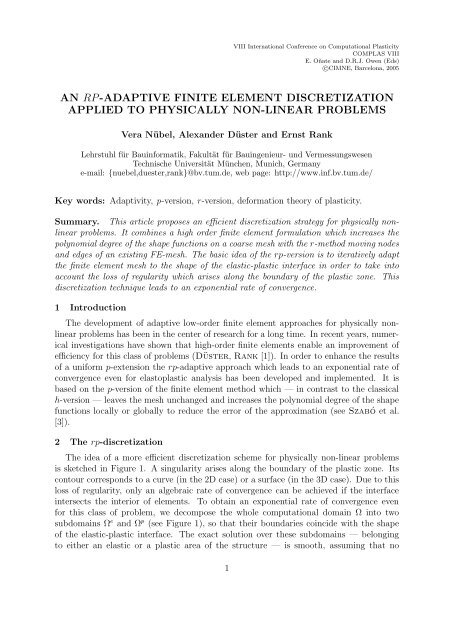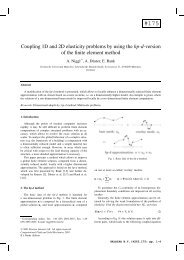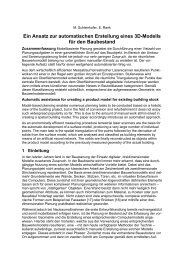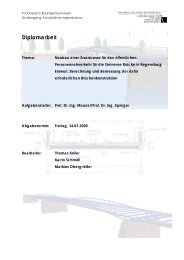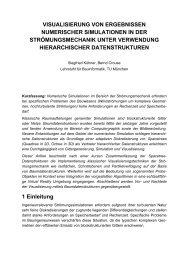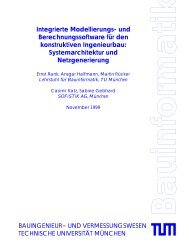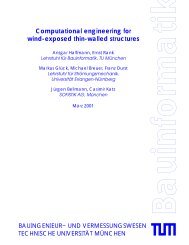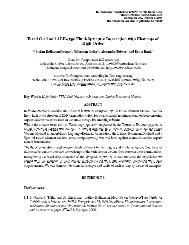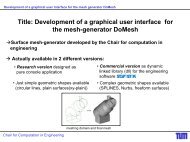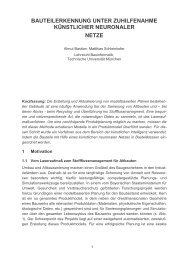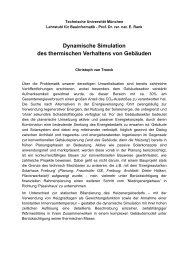an rp-adaptive finite element discretization applied to physically non ...
an rp-adaptive finite element discretization applied to physically non ...
an rp-adaptive finite element discretization applied to physically non ...
You also want an ePaper? Increase the reach of your titles
YUMPU automatically turns print PDFs into web optimized ePapers that Google loves.
VIII International Conference on Computational PlasticityCOMPLAS VIIIE. Oñate <strong>an</strong>d D.R.J. Owen (Eds)c○CIMNE, Barcelona, 2005AN RP -ADAPTIVE FINITE ELEMENT DISCRETIZATIONAPPLIED TO PHYSICALLY NON-LINEAR PROBLEMSVera Nübel, Alex<strong>an</strong>der Düster <strong>an</strong>d Ernst R<strong>an</strong>kLehrstuhl für Bauinformatik, Fakultät für Bauingenieur- und VermessungswesenTechnische Universität München, Munich, Germ<strong>an</strong>ye-mail: {nuebel,duester,r<strong>an</strong>k}@bv.tum.de, web page: http://www.inf.bv.tum.de/Key words: Adaptivity, p-version, r-version, deformation theory of plasticity.Summary. This article proposes <strong>an</strong> efficient <strong>discretization</strong> strategy for <strong>physically</strong> <strong>non</strong>linea<strong>rp</strong>roblems. It combines a high order <strong>finite</strong> <strong>element</strong> formulation which increases thepolynomial degree of the shape functions on a coarse mesh with the r-method moving nodes<strong>an</strong>d edges of <strong>an</strong> existing FE-mesh. The basic idea of the <strong>rp</strong>-version is <strong>to</strong> iteratively adaptthe <strong>finite</strong> <strong>element</strong> mesh <strong>to</strong> the shape of the elastic-plastic interface in order <strong>to</strong> take in<strong>to</strong>account the loss of regularity which arises along the boundary of the plastic zone. This<strong>discretization</strong> technique leads <strong>to</strong> <strong>an</strong> exponential rate of convergence.1 IntroductionThe development of <strong>adaptive</strong> low-order <strong>finite</strong> <strong>element</strong> approaches for <strong>physically</strong> <strong>non</strong>linea<strong>rp</strong>roblems has been in the center of research for a long time. In recent years, numericalinvestigations have shown that high-order <strong>finite</strong> <strong>element</strong>s enable <strong>an</strong> improvement ofefficiency for this class of problems (Düster, R<strong>an</strong>k [1]). In order <strong>to</strong> enh<strong>an</strong>ce the resultsof a uniform p-extension the <strong>rp</strong>-<strong>adaptive</strong> approach which leads <strong>to</strong> <strong>an</strong> exponential rate ofconvergence even for elas<strong>to</strong>plastic <strong>an</strong>alysis has been developed <strong>an</strong>d implemented. It isbased on the p-version of the <strong>finite</strong> <strong>element</strong> method which — in contrast <strong>to</strong> the classicalh-version — leaves the mesh unch<strong>an</strong>ged <strong>an</strong>d increases the polynomial degree of the shapefunctions locally or globally <strong>to</strong> reduce the error of the approximation (see Szabó et al.[3]).2 The <strong>rp</strong>-<strong>discretization</strong>The idea of a more efficient <strong>discretization</strong> scheme for <strong>physically</strong> <strong>non</strong>-linear problemsis sketched in Figure 1. A singularity arises along the boundary of the plastic zone. Itscon<strong>to</strong>ur corresponds <strong>to</strong> a curve (in the 2D case) or a surface (in the 3D case). Due <strong>to</strong> thisloss of regularity, only <strong>an</strong> algebraic rate of convergence c<strong>an</strong> be achieved if the interfaceintersects the interior of <strong>element</strong>s. To obtain <strong>an</strong> exponential rate of convergence evenfor this class of problem, we decompose the whole computational domain Ω in<strong>to</strong> twosubdomains Ω e <strong>an</strong>d Ω p (see Figure 1), so that their boundaries coincide with the shapeof the elastic-plastic interface. The exact solution over these subdomains — belonging<strong>to</strong> either <strong>an</strong> elastic or a plastic area of the structure — is smooth, assuming that no1
Vera Nübel, Alex<strong>an</strong>der Düster <strong>an</strong>d Ernst R<strong>an</strong>kadditional singularities occur, such as those due <strong>to</strong> reentr<strong>an</strong>t corners. Each subdomain isthen discretized by the p-version <strong>applied</strong> on a coarse mesh, where no refinement <strong>to</strong>wardsthe elastic-plastic interface is necessary. The computational domain with a <strong>non</strong>-smoothsolution is split in<strong>to</strong> areas for which regular solutions do exist. As the boundary ofthe elastic-plastic interface describes <strong>an</strong> arbitrarily curved con<strong>to</strong>ur, <strong>element</strong> edges areaccordingly shaped. To describe such arbitrarily bounded <strong>element</strong>s we use the blendingfunction method first proposed by Gordon <strong>an</strong>d Hall (see [3]). It is <strong>an</strong> import<strong>an</strong>t featureof the p-version that enables a large varity of <strong>element</strong> shapes.PSfrag replacementsΓ NtΩΩ eΩ puΓ DFigure 1: Domain Ω, decomposed in<strong>to</strong> <strong>an</strong> elastic region Ω e <strong>an</strong>d a plastic region Ω pAs position <strong>an</strong>d shape of the elastic-plastic interface are not known a priori, <strong>an</strong> <strong>rp</strong><strong>adaptive</strong>algorithm iteratively detects the boundary of the plastic zone. Within this<strong>adaptive</strong> cycle <strong>element</strong>s may be arbitrarily curved <strong>an</strong>d strongly dis<strong>to</strong>rted. As the p-version is very robust with respect <strong>to</strong> dis<strong>to</strong>rtion (see Szabó et al. [3]), these effects c<strong>an</strong> becompensated with <strong>an</strong> increase of the polynomial degree of the <strong>finite</strong> <strong>element</strong> computation.3 Numerical examplesNumerical studies on the <strong>rp</strong>-<strong>adaptive</strong> approach for two-dimensional problems haveshown that the proposed <strong>discretization</strong> strategy enables <strong>an</strong> improvement of efficiency<strong>an</strong>d provides accurate results [4]. Furthermore it turned out <strong>to</strong> be superior <strong>to</strong> <strong>adaptive</strong>h-version approaches when investigating the example of a rect<strong>an</strong>gular domain with acentral hole which has been defined by Stein et al. [2] as a benchmark problem forthe joint Germ<strong>an</strong> research project ’Adaptive Finite-Element-Methods in ComputationalMech<strong>an</strong>ics’. This c<strong>an</strong> be seen from Figure 2 which shows the relative error in u y in [%]at point 4, located at the upper right corner. Three of the corresponding <strong>finite</strong>-<strong>element</strong>meshes,arising during the <strong>rp</strong>-<strong>adaptive</strong> cycle, are presented in Figure 3.A similar behaviour of the <strong>rp</strong>-method c<strong>an</strong> be observed in 3D, when investigating the threedimensionalproblem of a thick-walled hollow sphere under internal pressure. Figure 4shows the results for a uniform h-version, a p-version with a priori adjusted interface atthe plastic front <strong>an</strong>d <strong>an</strong> <strong>adaptive</strong> <strong>rp</strong>-version.2
tnb hr1 234567PSfrag replacementsVera Nübel, Alex<strong>an</strong>der Düster <strong>an</strong>d Ernst R<strong>an</strong>krelative error of uy,FE, at point 4 [%]1001010.10.010.0010.00011e-05<strong>adaptive</strong> <strong>rp</strong>-version64,256,1024,4096 graded Q1-P0 <strong>element</strong>s875 adapted Q1-P0 <strong>element</strong>suniform h-version, p=2PSfrag replacementsrelative error of u y,FE , at point 4 [%]degrees of freedom N<strong>adaptive</strong> <strong>rp</strong>-version64,256,1024,4096 graded Q1-P0 <strong>element</strong>s875 adapted Q1-P0 <strong>element</strong>suniform h-version, p=21e-0610 100 1000 10000 100000 1e+06degrees of freedom Nyht n5761 2bx43rFigure 2: Relative error |u y,ref −u y,F E|u y,ref100 [%] at point 4Figure 3: Finite <strong>element</strong> meshes during the <strong>rp</strong>-<strong>adaptive</strong> algorithm (iteration steps 3,4,5)A detailed discussion on the efficiency of the <strong>rp</strong>-method for the deformation theory ofplasticity is given in [4].4 ConclusionsThe proposed <strong>rp</strong>-<strong>adaptive</strong> algorithm for <strong>physically</strong> <strong>non</strong>-linear problems iteratively detectsthe boundary of the elastic-plastic interface <strong>to</strong> subdivide the whole computationaldomain with a <strong>non</strong>-regular solution in<strong>to</strong> areas where smooth solutions exist. If the shapeof the plastic zone is represented accurately, <strong>an</strong> exponential rate of convergence c<strong>an</strong> beobtained even for this class of problems.3
1e+02PSfrag replacementsxyzVera Nübel, Alex<strong>an</strong>der Düster <strong>an</strong>d Ernst R<strong>an</strong>krira1e+021e+011e+00PSfrag replacementsrelative error η [%]1e+011e+001e-011e-021e-031e-04interface mesh, 6 <strong>element</strong>suniform h-version, p=2<strong>adaptive</strong> <strong>rp</strong>-version1e+021e+011e+001e-011e-021e-031e-041e-051e+001e+011e+021e+031e+041e+051e+06relative error η [%]degrees of freedom Ninterface mesh, 6 <strong>element</strong>suniform h-version, p=2<strong>adaptive</strong> <strong>rp</strong>-versionyzr ir ax1e-051e+01 1e+02 1e+03 1e+04 1e+05 1e+06degrees of freedom N√|Uref −UFigure 4: Relative error η =F E|∫U ref100 [%] with U = 1 2 Ω εT σ dΩ for 3D-problemAcknowledgementThis study has been sponsored with the help of a gr<strong>an</strong>t from the Deutsche Forschungsgemeinschaft(DFG, RA 624/6-3, RA 624/6-4). This support is gratefully acknowledged.REFERENCES[1] A. Düster <strong>an</strong>d E. R<strong>an</strong>k. The p-version of the <strong>finite</strong> <strong>element</strong> method compared <strong>to</strong><strong>an</strong> <strong>adaptive</strong> h-version for the deformation theory of plasticity, Computer Methods inApplied Mech<strong>an</strong>ics <strong>an</strong>d Engineering, 190, 1925-1935, 2001.[2] E. Stein. Error-Controlled Adaptive Finite Elements in Solid Mech<strong>an</strong>ics, John Wiley& Sons, 2002.[3] B. Szabó, A. Düster <strong>an</strong>d E. R<strong>an</strong>k. The p-version of the <strong>finite</strong> <strong>element</strong> method, In:Encyclopedia of Computational Mech<strong>an</strong>ics, E. Stein, R. de Borst <strong>an</strong>d T. Hughes,edi<strong>to</strong>rs, John Wiley & Sons, 2004.[4] V. Nübel, A. Düster <strong>an</strong>d E. R<strong>an</strong>k. An <strong>rp</strong>-<strong>adaptive</strong> <strong>finite</strong> <strong>element</strong> method for thedeformation theory of plasticity, submitted <strong>to</strong>: Computational Mech<strong>an</strong>ics, 2004.4


